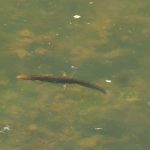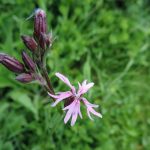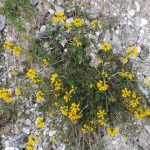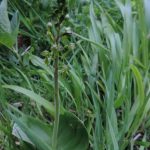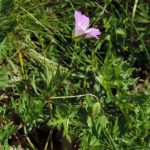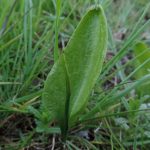On the sunny afternoon of 15 May 2016, 20 RDNHS members led by Sally Rankin and Alan Parfitt gathered at Kings Barn Farm, Medmenham, for a walk through the large estate of Susan and Leonard Phillips. This was the second visit of the Society to the site; the previous one was on 16 June 2013. Before the walk started we admired newts and tadpoles in the pond near the farm house. Rigid Hornwort (Ceratophyllum demersum) was growing in the pond with Meadow Buttercup (Ranunculus acris) and Cuckooflower (Cardamine pratensis) adorning the margins. A Buzzard (Buteo buteo) and two Red Kites (Milvus milvus) flew over. Susan Phillips had explained the management plans for the estate to the members that had come on the earlier visit, such as making scrapes in the fields to encourage butterflies and other insects. One field had been sprayed in 2011 and sown with wildflower seeds the following year. Cowslips (Primula veris) were flowering and thriving here, but Oxeye Daisies (Leucanthemum vulgare) were only in bud. Susan took us to the scrapes where we saw Horseshoe Vetch (Hippocrepis comosa), Common Rock-rose (Helianthemum nummularium), Thyme (Thymus spec.), Meadow Saxifrage (Saxifraga granulata), Wild Strawberry (Fragaria vesca), Kidney Vetch (Anthyllis vulneraria, in bud), White Campion (Silene latifolia), Betony leaves (Betonica officinalis), Thyme-leaved Sandwort (Arenaria serpyllifolia), Wall Speedwell (Veronica arvensis) and very large specimens of Salad Burnet, which may have been the Fodder Burnet (Poterium sanguisorba subsp. muricata). To our delight we also rediscovered the Long-stalked Crane’s-bill (Geranium columbinum), which we had admired there three years ago.
Everywhere that we followed Susan through the fields, the deep-blue flowers of Germander Speedwell (Veronica chamaedrys), pink ones of Dove’s-foot Crane’s-bill (Geranium molle), pale blue ones of Thyme-leaved Speedwell (Veronica serpyllifolia) and the tiny pink starry flowers of Field Madder (Sherardia arvensis) were greeting us. When we looked up, there were splendid views of the sloping meadows and woods beyond, with the leaves of the trees in various shades of light green. A further field was bordered by hundreds of flowering Garlic Mustard plants (Alliaria petiolata) and here we also saw leaves and buds of the Bee Orchids (Ophrys apifera) that had recently been planted there. One of the members caught a beautiful orange-yellow moth in his net called Clay Triple-lines (Cyclophora cinearia). The butterflies we saw this afternoon included Common Blue (Polyommatus icarus), Brimstone (Gonepteryx rhamni), Peacock (Inachis io) and Red Admiral (Vanessa atalanta). A stony patch showed some interesting weed species, such as Parsley-piert (Aphanes arvensis), Grey Field-speedwell (Veronica polita) and Scarlet Pimpernel (Anagallis arvensis), and we heard a Song Thrush (Turdus philomelos) singing.
On the way back we went through the woods of the estate, with acres of Bluebells (Hyacinthoides non-scripta), which unfortunately had just finished flowering, as had Lesser Celandine (Ficaria verna), Dog’s Mercury (Mercurialis perennis), Spurge-laurel (Daphne laureola) and Primrose (Primula vulgaris). Still in flower were Greater Stitchwort (Stellaria holostea), Wood Spurge (Euphorbia amygdaloides), Yellow Archangel (Lamiastrum galeobdolon) and Bugle (Ajuga reptans). Other plants included Rough Meadow-grass (Poa trivialis), Common Figwort (Scrophularia nodosa, not yet in flower), Bracken (Pteridium aquilinum), Foxglove (Digitalis purpurea, in bud), Hairy St John’s-wort (Hypericum hirsutum, not yet in flower), Box (Buxus sempervirens) and Spindle (Euonymus europaeus).
The final field, covered with a natural vegetation of chalk plants, was another highlight. A Bee-fly (Bombylius major) poked its long proboscis into the flowers, seemingly hovering above them, but clinging with one pair of legs to the flowers. We saw amongst others Common Milkwort (Polygala vulgaris), leaves of Wild Basil (Clinopodium vulgare) and Marjoram (Origanum vulgare), Quaking-grass (Briza media), Glaucous Sedge (Carex flacca), Downy Oat-grass (Avenula pubescens), leaves of Harebell (Campanula rotundifolia) and, unfortunately, also the invasive Tor-grass (Brachypodium rupestre). However, we were very pleased to discover Adder’s-tongue (Ophioglossum vulgatum) again. Between the long grasses we saw dozens of fronds of this rare fern, the sporangia just appearing. In this area the nightly activity of Badgers (Meles meles) was clearly visible. This may be a threat to the survival of the ferns, or, in contrast, the Adder’s-tongue may need this activity in order to compete with the grasses.
Report by Renée Grayer
Pictures by Rob Stallard
| RDNHS trip to Kings Barn Farm, Medmenham, 15.05.16 | ||
| Scientific names | British names | Remarks |
| Plant species: | ||
| Ajuga reptans | Bugle | |
| Alliaria petiolata | Garlic Mustard | |
| Alopecurus geniculatus | Marsh Foxtail | |
| Anagallis arvensis | Scarlet Pimpernel | |
| Anthriscus sylvestris | Cow Parsley | |
| Aphanes arvensis | Parsley-piert | |
| Arenaria serpyllifolia | Thyme-leaved Sandwort | |
| Avenula pubescens | Downy Oat-grass | |
| Betonica officinalis | Betony | |
| Brachypodium rupestre | Tor-grass | |
| Briza media | Quaking-grass | |
| Bromus erectus | Upright Brome | |
| Buxus sempervirens | Box | |
| Campanula rotundifolia | Harebell | Not flowering yet |
| Cardamine pratensis | Cuckooflower | |
| Carex flacca | Glaucous Sedge | |
| Cerastium glomeratum | Sticky Mouse-ear | |
| Ceratophyllum demersum | Rigid Hornwort | |
| Clinopodium vulgare | Wild Basil | Not flowering yet |
| Daphne laureola | Spurge-laurel | |
| Digitalis purpurea | Foxglove | Not flowering yet |
| Epilobium parviflorum | Hoary Willowherb | |
| Euonymus europaeus | Spindle | |
| Euphorbia amygdaloides | Wood spurge | |
| Ficaria verna | Lesser Celandine | Finished flowering |
| Galium odoratum | Woodruff | |
| Geranium columbinum | Long-stalked Crane’s-bill | |
| Geranium dissectum | Cut-leaved Crane’s-bill | |
| Geranium molle | Dove’s-foot Crane’s-bill | |
| Geranium robertianum | Herb-Robert | |
| Geum urbanum | Wood Avens | |
| Glechoma hederacea | Ground-ivy | |
| Helianthemum nummularium | Common Rock-rose | |
| Hippocrepis comosa | Horseshoe Vetch | |
| Hyacinthoides non-scripta | Bluebell | Finished flowering |
| Hypericum hirsutum | Hairy St John’s-wort | |
| Ilex aquifolium | Holly | |
| Lamiastrum galeobdolon | Yellow Archangel | |
| Leucanthemum vulgare | Oxeye Daisy | In bud |
| Lotus corniculatus | Common Bird’s-foot-trefoil | |
| Mercurialis perennis | Dog’s Mercury | |
| Myosotis arvensis | Field Forget-me-not | |
| Neottia ovata | Common Twayblade | In bud |
| Ophioglossum vulgatum | Adder’s-tongue | |
| Ophrys apifera | Bee Orchid | |
| Origanum vulgare | Majoram | Leaves only |
| Poa pratensis | Smooth Meadow-grass | |
| Poa trivialis | Rough Meadow-grass | |
| Polygala vulgaris | Common Milkwort | |
| Potentilla anserina | Silverweed | Not flowering yet |
| Poterium sanguisorba ssp. muricata | Fodder Burnet | |
| Poterium sanguisorba ssp. sanguisorba | Salad Burnet | |
| Primula veris | Cowslip | |
| Primula vulgaris | Primrose | |
| Pteridium aquilinum | Bracken | |
| Ranunculus acris | Meadow Buttercup | |
| Ranunculus bulbosus | Bulbous Buttercup | |
| Reseda luteola | Weld | |
| Rhinanthus minor | Yellow-rattle | |
| Rhinanthus minor | Yellow-rattle | |
| Scrophularia nodosa | Common Figwort | Not flowering yet |
| Sherardia arvensis | Field Madder | |
| Silene flos-cuculi | Ragged-Robin | |
| Silene latifolia | White Campion | |
| Stellaria holostea | Greater Stitchwort | |
| Thymus spec. | Thyme | |
| Tussilago farfara | Colt’s-foot | Leaves |
| Ulmus glabra | Wych Elm | |
| Verbascum thapsus | Great Mullein | Leaf rosette |
| Veronica arvensis | Wall Speedwell | |
| Veronica chamaedrys | Germander Speedwell | |
| Veronica montana | Wood Speedwell | |
| Veronica polita | Grey Field-speedwell | |
| Veronica serpyllifolia | Thyme-leaved Speedwell | |
| Viburnum lantana | Wayfaring-tree | |
| Vicia sativa | Common Vetch | |
| Vulpia bromoides | Squirreltail Fescue | |
| Bird species: | ||
| Buteo buteo | Buzzard | |
| Milvus milvus | Red Kite | |
| Turdus philomelos | Song Thrush | |
| Butterfly and moth species: | ||
| Cyclophora linearia | Clay Triple-lines | |
| Gonepteryx rhamni | Brimstone | |
| Inachis io | Peacock | |
| Polyommatus icarus | Common Blue | |
| Vanessa atalanta | Red Admiral | |
| Other insect species: | ||
| Bombylius major | Bee Fly | |
List by Renée Grayer

